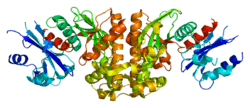Pantothenate kinase 1 is an enzyme that in humans is encoded by the PANK1 gene.[5]
This gene encodes a protein belonging to the pantothenate kinase family. Pantothenate kinase is a key regulatory enzyme in the biosynthesis of coenzyme A (CoA) in bacteria and mammalian cells. It catalyzes the first committed step in the universal biosynthetic pathway leading to CoA and is itself subject to regulation through feedback inhibition by CoA. Alternative splicing has been observed at this locus and three variants, each encoding a distinct isoform, have been identified.[5]
Further reading
- Robishaw JD, Neely JR (1985). "Coenzyme A metabolism". Am. J. Physiol. 248 (1 Pt 1): E1–9. PMID 2981478.
- Hong BS, Senisterra G, Rabeh WM, et al. (2007). "Crystal structures of human pantothenate kinases. Insights into allosteric regulation and mutations linked to a neurodegeneration disorder". J. Biol. Chem. 282 (38): 27984–93. doi:10.1074/jbc.M701915200. PMID 17631502.
- Gerhard DS, Wagner L, Feingold EA, et al. (2004). "The status, quality, and expansion of the NIH full-length cDNA project: the Mammalian Gene Collection (MGC)". Genome Res. 14 (10B): 2121–7. doi:10.1101/gr.2596504. PMC 528928. PMID 15489334.
- Deloukas P, Earthrowl ME, Grafham DV, et al. (2004). "The DNA sequence and comparative analysis of human chromosome 10". Nature. 429 (6990): 375–81. doi:10.1038/nature02462. PMID 15164054.
- Ramaswamy G, Karim MA, Murti KG, Jackowski S (2004). "PPARalpha controls the intracellular coenzyme A concentration via regulation of PANK1alpha gene expression". J. Lipid Res. 45 (1): 17–31. doi:10.1194/jlr.M300279-JLR200. PMID 14523052.
- Strausberg RL, Feingold EA, Grouse LH, et al. (2003). "Generation and initial analysis of more than 15,000 full-length human and mouse cDNA sequences". Proc. Natl. Acad. Sci. U.S.A. 99 (26): 16899–903. doi:10.1073/pnas.242603899. PMC 139241. PMID 12477932.
- Westaway SK, Hayflick SJ, Zhou B, Gitschier JD (2003). "In reference to the Short Communication published by Ni et al". Int. J. Biochem. Cell Biol. 34 (12): 1629. doi:10.1016/S1357-2725(02)00125-5. PMID 12379284.
- Zhou B, Westaway SK, Levinson B, et al. (2001). "A novel pantothenate kinase gene (PANK2) is defective in Hallervorden-Spatz syndrome". Nat. Genet. 28 (4): 345–9. doi:10.1038/ng572. PMID 11479594.
PDB gallery |
|---|
2i7n: Crystal structure of human PANK1 alpha: the catalytic core domain in complex with AcCoA |





